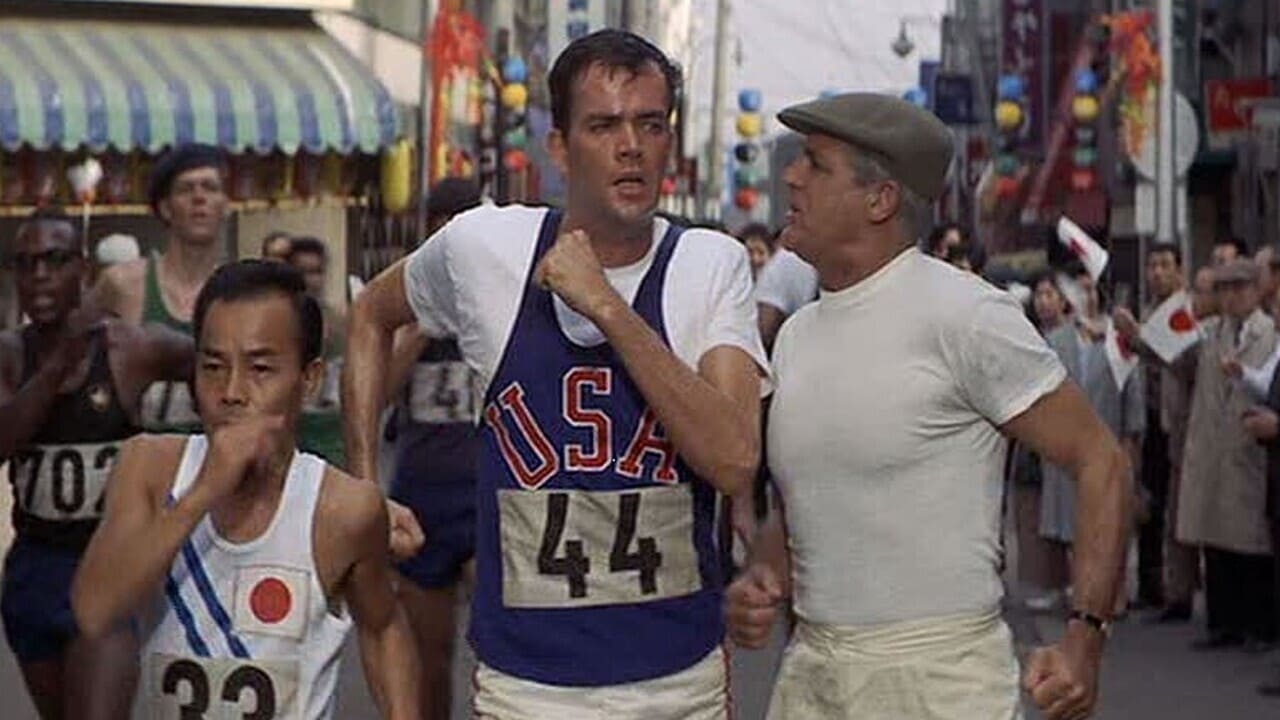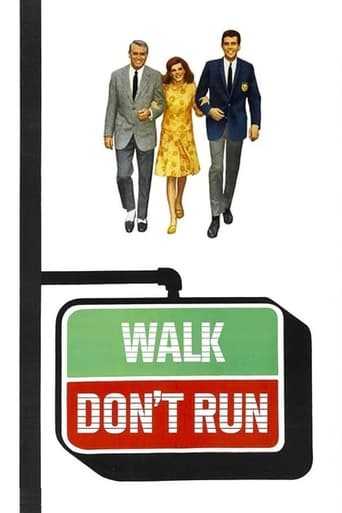

Stylish but barely mediocre overall
... View MoreWhat a freaking movie. So many twists and turns. Absolutely intense from start to finish.
... View MoreI am only giving this movie a 1 for the great cast, though I can't imagine what any of them were thinking. This movie was horrible
... View MoreThis is one of the few movies I've ever seen where the whole audience broke into spontaneous, loud applause a third of the way in.
... View MoreFilmed in Panavision. Color by Technicolor. A Sol C. Siegel Production: A Granley Company Presentation: A Columbia Pictures Release. Executive producer: Cary Grant. Copyright 1 July 1966 by Walk Co. New York opening at Loew's State and 22 other cinemas: 24 August 1996. U.S. release: 29 June 1966. U.K. release: 5 August 1966. The movie fared so poorly in Australia, Columbia didn't even bother to record a release date. I think it opened in Sydney at the Lyceum. 10,220 feet. 114 minutes.SYNOPSIS: In Tokyo during the Olympic games, English industrialist Sir William Rutland is unable to find a room until he talks lovely young Christine Easton into letting him share her apartment. Later, meeting American athlete and architect Steve Davis, Rutland sneaks him into the place as well. Morning is especially complicated in the tiny apartment, what with breakfast and the bathroom and Christine's irate discovery of Steve's presence. Christine is engaged to a British Embassy official, Julius Haversack, whom Rutland finds a complete bore, especially when he becomes officious after Christine, now "living" with two men, also is suspected of espionage.NOTES:A re-make of "The More the Merrier". Location scenes filmed in Japan. Cary Grant's last movie prior to his permanent retirement from the screen. With a domestic rentals gross of $4 million, the movie was a top box-office success in the U.S., but overseas it failed to pull in the customers. John Standing's mother is Kay Hammond, his grandfather was Sir Guy Standing. COMMENT: Charles Walters is not one of my favorite directors, but he has used the CinemaScope screen with moderate effectiveness here. Of course he does have the advantage of a superior script. It's very funny. Even though it omits two of the original's best jokes. And even though the present cast, Grant excepted of course, isn't half as attractive as the old.The change of setting from wartime Washington to Olympiad Tokyo is both apt and agreeable. In keeping with this updating, the scriptwriter has contrived new second and third acts that are just as engaging as the original. In fact some of the new jokes are very hilarious indeed!
... View More. . . soundtrack than WALK, DON'T RUN, so the former rates higher on the all-time list of flicks about the Olympics. However, since Columbia Pictures churned out WALK, DON'T RUN (probably the most famous film ever made in Japan), Sony Corporation snapped up Columbia the first chance it got in order to collect the treasure chests of royalties accumulating during WALK's semi-annual re-releases throughout that Asian island nation. Besides becoming a cash cow for Sony, WALK is remembered today as one of Cary Grant's best-documented showings in an Olympic competition. Though the world record for the 50 km walk has improved from 4 hours, 50 seconds to 3:32:33 since 1964, there's little doubt that Grant still would be able to stroll along with the best of them if he had not suddenly succumbed in 1986. (Considering that he has born Archibald Leach, Cary may well have won many Olympic medals in the lesser-known events under various aliases and nationalities.) Other than the Tokyo Olympics, the plot of WALK revolves around a Japanese sex toy that enables swingers to introduce newbies to their lifestyle by suddenly lowering the partitions between the bedrooms of adjoining apartments at bedtime through the use of a universal remote control. Oh what fun!
... View MoreBottom Line on top: I give the film a 3 out of 10 for those viewers who watch this remake film without ever having seen the original. While you are not aware of what you are missing, I am. Therefore, I want you folks reading my review to really get this: If you end up liking "Walk, Don't Run", well then, RUN, DON'T WALK to the TCM site to purchase "The More the Merrier" to have an absolutely fabulous comedy in your film collection to watch repeatedly and share with other TCM fans.I didn't know Walk, Don't Run was a remake when I decided to DVR it. I was 20 minutes in when I recognized positively it was a remake of "The More The Merrier". I watched the entire film; but, I have to tell you, it wasn't easy to stay with it. Why? Because saying this film lacked the Charm, Warmth and Wit of the original is an understatement .. well, if I could think of a word under understatement, I'd be using it. All I kept thinking was how much weaker the script was. How Samantha Eggar was NO JEAN ARTHUR by ANY comparison. How Samantha and Jim had zero chemistry compared to Jean Arthur and Joel McCrea. How Jim Hutton held no presence in the apartment-sharing scenes whether between him and Cary Grant or between him and Samantha compared to Joel with Jean and Charles Coburn. How Jim held none of the animal attraction I felt for Joel as Joel acted his way through this film in and out of the apartment. How I missed seeing Charles Coburn's performance in scenes with Jean or Joel and with Jean and Joel===as well as his typical acting nuances with other characters throughout the entire movie. Heck, I got to a point in the original where I waited for Charles Coburn and his antics to get back on screen, not caring if it would be with Jean and/or Joel .and I'm feeling that impatience while I'm enjoying the heck out of seeing Jean and Joel's interplay.I did like some of the exchanges between Cary and Jim; and I do believe they did some ad-libs between them that amused each other. I enjoyed rewinding those scenes to watch each man's facial reactions as they played off each other. Here's a huge rub I couldn't overcome. Charles Coburn could never be mistaken by the audience for the man that Jean Arthur would fall in love with from their first encounter on, even when he turned out to be rich. Joel enters that movie and there is clearly Jean's love interest. Cary, however, is 'Cary'. I mean look at and listen to him compared to Jim Hutton. Even if a later reveal gave Jim a 'Sir' title or money ..I still go with Cary, hoping he'll somehow get himself 'single' for me, if he is married.By the way, I watched and waited the entire movie for something about Samantha Eggar to make me give a rip about her and how her role plays out. Never cared. Her mannerisms, speech cadence, sex appeal sorry nothing there compared to Jean Arthur's performance.
... View MoreWalk Don't Run (1966)In my book, Cary Grant can do no wrong, and he absolutely makes this movie. It's a bit of a 1960s farce, and is maybe exactly what everyone was reacting against with the shift in movies around this time to greater realism and pertinence. This has neither!But that's okay, it has beauty (the sets, architecture, and widescreen filming are all really fabulous) and innocence, which is weird to remember. Even sweet romances from our time, like Sleepless in Seattle, don't have the same pure innocence of this, which I think is genuine in its own way. The scene is mid-60s Tokyo, which is hard to beat for interest (and great cars). The plot? Oh, I'm not sure it actually has one that matters, except boy meets girl. It's mostly like a super high class situation comedy, and the comedy is more important than the situation. And more important than both is Cary Grant, who is in great form. Yes, Jim Hutton is there (and he's fine but forgettable) as well as the female lead, Samantha Eggar (who is not as fine, but is fine anyway, and also forgettable). But then there is Cary Grant. There are even some odd gay gaze moments, where Grant, and the camera, check out the legs or body of a man (Grant, though married, was also gay, it appears). If you catch it it's almost shocking, but perhaps the audience was so innocent, as well, it was thought of as simply funny.So: drop Cary Grant beautifully in Tokyo and create a nonsensical series of little gags, and you have it. And it's Grant's last film.
... View More